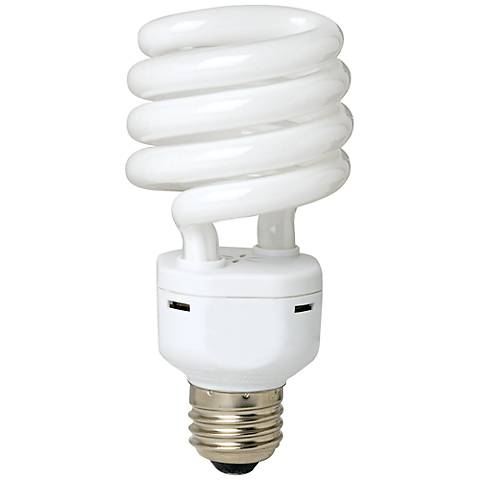I’m really getting fed up with the false lifetime claims of Compact Fluorescent Lighting manufacturers. On average, I’ve been seeing these bulbs fail at half their published life spans. Maybe we need a class action suit to force companies to publish the MTBF (Mean Time Between Failure) hours for these bulbs in the real world.
The issue isn’t with fluorescent technology. In my last home, an industrial loft that was previously a paper bag factory, I took possession of two dozen large fluorescent ceiling fixtures. I could tell from the dust on those bulbs that they were already years old. Nevertheless, every single one of them was still doing its job three years later when I replaced them with ceiling floods. They KNOW how to build a long-life CFL.
The issue is with the crap ballasts and starters in these things. Among the worst brands are big box no-names and Phillips. I only buy Westinghouse and Sylvania now, but the jury’s still out on them too.
However, yesterday I saw the future and it’s coming a lot quicker than I’d thought: the LED. If there’s any justice in the universe, the 8000 hour CFL you buy today will be a dinosaur when it’s supposed to expire.
Or maybe it will.
Yesterday, I went to Lowes to replace an LED lighting strip that had blown out a year after I bought it… about 49,000 hours shy of its 50,000 hour lifetime claim. The problem was an exploded 10 uF 50V capacitor in the circuitry, not the LED. Sound familiar? Once again, the bulb was willing but the electronics were weak.
I bought these LED strips for accent lighting on a tall shelf in the bathroom. I didn’t mind the characteristically dim and bluish light because it was what I wanted for that shelf. It’s supposed to be night lighting.
Nevertheless, I was angry at lighting manufacturers for leveraging the “green” argument only to suck the green out of our wallets with false reliability claims. As I was sorting through Lowes’ disheveled rack of lighting strips I was ranting to another shopper about it and not paying much attention to what I was actually buying.
As Karen and I were heading back in the car she asked to see my receipt. The bill seemed a bit high but I’d bought a lot of stuff, including a Black and Decker leaf vacuum, which started making noise and smoking ten minutes into its first use this morning… sheesh, I can’t catch a break. The LED strip cost $59, or about double the one I was replacing. And it only had five LEDs versus the twenty or so in the other strip.
I decided to return it but was curious what made this twice as good as the one I had. When I turned it on I was unprepared for how bright and white the light was. If I had another one of these strips I could almost get rid of the ceiling lighting in the bathroom altogether. It was like 60 watts of incandescent lighting drawing all of 5 watts.
What a difference a year’s made in consumer LED technology.
But it seems like we’re paying drastically more for lighting in order to save a little on the power bill but which is costing us far more in the long run because many of these lighting alternatives don’t practically outlive a standard incandescent light bulb by a heckuva lot.
![]()

